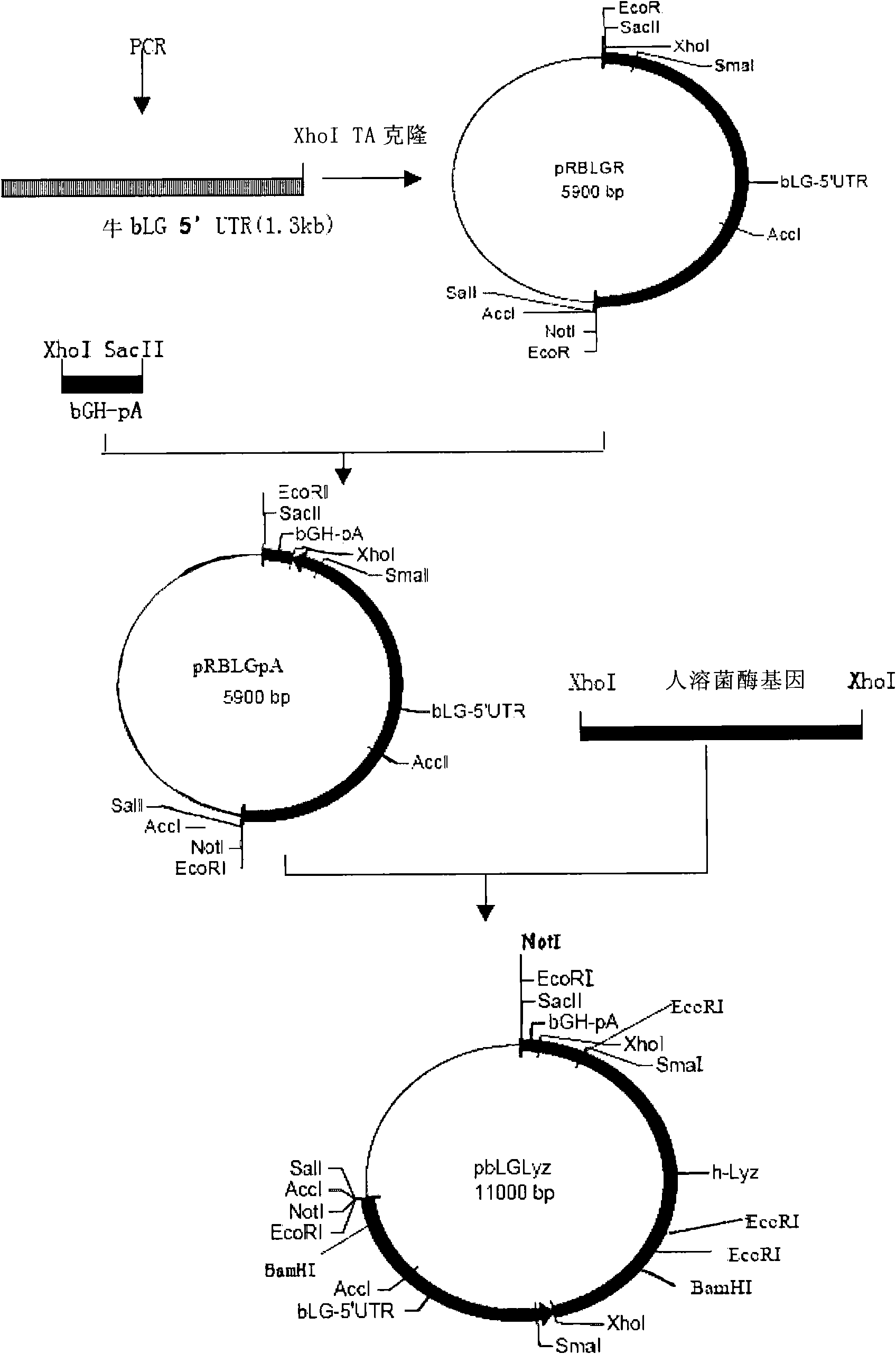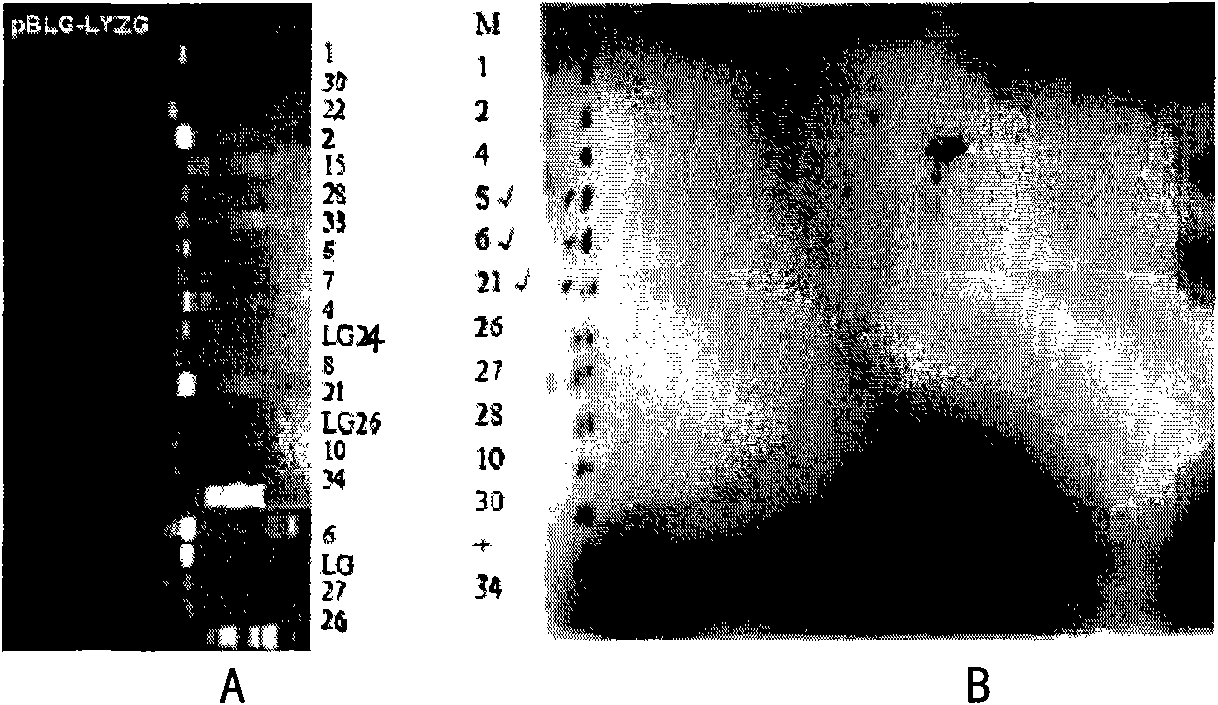Human lysozyme efficiently produced by utilizing mammary gland of domestic animal
A technology of human lysozyme and mammary gland, which is applied in the field of genetic engineering, can solve problems such as the lack of gene regulation methods, allergic reactions, and the difficulty in obtaining large quantities of natural human lysozyme.
- Summary
- Abstract
- Description
- Claims
- Application Information
AI Technical Summary
Problems solved by technology
Method used
Image
Examples
Embodiment 1
[0145] Example 1 Isolation of Saaneng Dairy Goat Fetal Fibroblast Cell Line
[0146] Male and female Saanen milk goats (Shanghai Transgenic Research Center Experimental Ranch) were bred 35 days later and the uterus of the ewes was surgically removed, and the uterus containing the fetus was put into sterilized normal saline. The goat fetuses were separated from the uterus, washed twice with PBS, sterilized with 70% ethanol, and washed twice with PBS. Use surgical scissors to peel off the fetal membranes in PBS, remove the head and liver, cut up the fetal tissue with tissue scissors, and spread it on a 100mm cell culture dish. Use GMEM culture medium containing 10% FBS, penicillin and non-essential amino acids at 37°C, 5% CO 2 , Cultivate under saturated humidity, observe the cell adhesion, replace the culture medium during the period, and remove the tissue blocks. As a result, when the primary cells were cultured to 80% confluence, observed under a microscope, the cells showe...
Embodiment 2
[0147] The construction of the mammary gland-specific expression vector of embodiment 2 human lysozyme gene
[0148] according to figure 1 Finally, the mammary gland-specific expression vector pbLGLyz of the human lysozyme gene was obtained, and the construction method was as follows: Design and synthesize the following primers according to the sequence in GENBANK accession number X14710:
[0149] 5'-cggccgggggtctgctcc-3' (SEQ ID NO: 1), and
[0150] 5'-ctcgagggctgcagctggggtcac-3' (SEQ ID NO: 2).
[0151]Using bovine genomic DNA as a template, the bovine β-lactoglobulin 5' flanking sequence (BLG-5' UTR) (-1215 ~ +45 bp), the PCR product was cloned into the pGEM-T-easy vector to obtain the plasmid pRBLGR. XhoI+SacII double-cut recombinant plasmid pTA-BGH obtained bovine auxin gene 3'UTR (PolyA sequence) (bGH-PA) with a size of 300bp, which was recovered and cloned into plasmid pRBLGR to form pRBLGpA. Finally, the human lysozyme gene (h-Lyz) was excised from pcDNA-LYZ with X...
Embodiment 3
[0153] Example 3 Co-transfected goat fetal fibroblasts and screening and identification of resistant clones
[0154] The expression framework of pbLGlyz was cut out with NotI enzyme, and the double marker selection vector pLNK( figure 2 ) expression frame was cut out, mixed according to the ratio (molar ratio) of pbLGlyz:pLNK=5:1, and electroporation method was used to co-transfect fetal fibroblasts, electric shock parameters: 0.4kV, 500uF. After the electric shock, let it stand for 10 minutes, wash out the cells with GEF complete culture medium, inoculate evenly in ten 100mm cell culture dishes, and place them at 37°C, 5% CO 2 Culture in an incubator; replace the selection medium (containing G418) 48 hours after transfection, and then replace the selection medium every two days until obvious cell clones are formed.
[0155] After the formation of cell clones, the clones were picked with a cloning ring, and passaged sequentially from the 96-well plate to the 48-well, 24-well...
PUM
 Login to View More
Login to View More Abstract
Description
Claims
Application Information
 Login to View More
Login to View More - R&D
- Intellectual Property
- Life Sciences
- Materials
- Tech Scout
- Unparalleled Data Quality
- Higher Quality Content
- 60% Fewer Hallucinations
Browse by: Latest US Patents, China's latest patents, Technical Efficacy Thesaurus, Application Domain, Technology Topic, Popular Technical Reports.
© 2025 PatSnap. All rights reserved.Legal|Privacy policy|Modern Slavery Act Transparency Statement|Sitemap|About US| Contact US: help@patsnap.com



